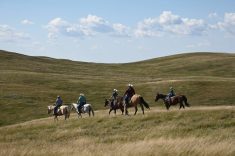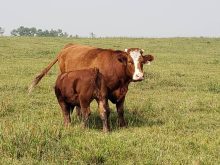A cow herd really is a team effort. In most cow herds there are a few rookies, a core group of players and some grizzled old vets.
Just like any team through junior high, high school, college or the pros, there are some fundamentals required to make a good team. First, the new recruits need a bit of coaching on where to go, what to do, what to graze, et cetera. This is true not only for new entrants from within the herd, but also purchased cows. Often cows that come into a herd aren’t aware of the systems in place, or even what plants are good grazing.
There are a few problems a cow herd team can have that really cause damage, and surprisingly they are quite similar to those in a human team.
Read Also

Harvest wraps up and fall work begins
At the Eppich famly ranch in western Saskatchewan, the fall harvest was successful with few breakdowns, cows and calves have been sorted and a new tractor has arrived
Failing to fit
Some cows may come into a system or a team and just be unable to fit in with what is going on. That doesn’t mean they are not good players, but it may mean their talents are better suited for a different playing style. This could be cows that are in a low-input, grazing system trying to keep up with the power of cows in a more high-octane system — or it could be the reverse. Sometimes players just don’t fit the overall scheme of things. We don’t want to sign a goalie when we are really looking for a power forward.
Not a team player
This could be something as simple as being aggressive toward coaches and ownership, or more complex, such as choosing to leave the playing field at inopportune times (fence-crawling). It sometimes takes a bit of time for a cow to adapt to her new teammates and understand the pecking order — but some things are relatively inexcusable. It partly relates to non-performance, but cows that require extra attention or care relative to their teammates are a drag on the entire roster. It’s often a fine line between a cow learning the game versus a cow being a literal on- and off-field distraction.

Non-performance
This may also seem basic and, as previously mentioned, it may take a while for new recruits to really learn the game. For example, we don’t necessarily expect the calves from first-calf heifers to weigh the same at weaning as calves from mature cows. That said, various teams have different expectations and teammates need to meet these expectations at the risk of shortened careers and being traded.
Sometimes we can end up with a recruit that creates a lot of team drama or is not a good fit. It is often better to trade your way out of this team member and search for a better fit. That also goes for injury-prone players. Every time we add new herd members we need to empower their success, but we also need to hold them accountable and not adjust the rest of the team just to make a few new players happy.
Salary cap
Most operations work on a salary cap. There is only so much money that can go into players and at the end of the day it is nice to have a bit left for the coach and ownership. While we may have our favourite players (remember old No. 27?) it’s important that everyone pulls their weight toward the end goal.
I think it’s also fair to state every team needs a coach whose playing style matches the environment and the players. That is the role of the farm or ranch manager. The players need to clearly understand the expectations of the system and ownership needs to work to ensure the right players are in place. It’s possible to adapt the system to the cows — but be aware of the salary cap and if you want to pay for a team of superstars or grinders.
There are a lot of teams of cows with different playing styles that can be extremely successful. The trick is making sure that the style matches management resources and coaching. Additionally, it’s important to know the system you are working in and ensure players are accountable to whatever standard that requires.















